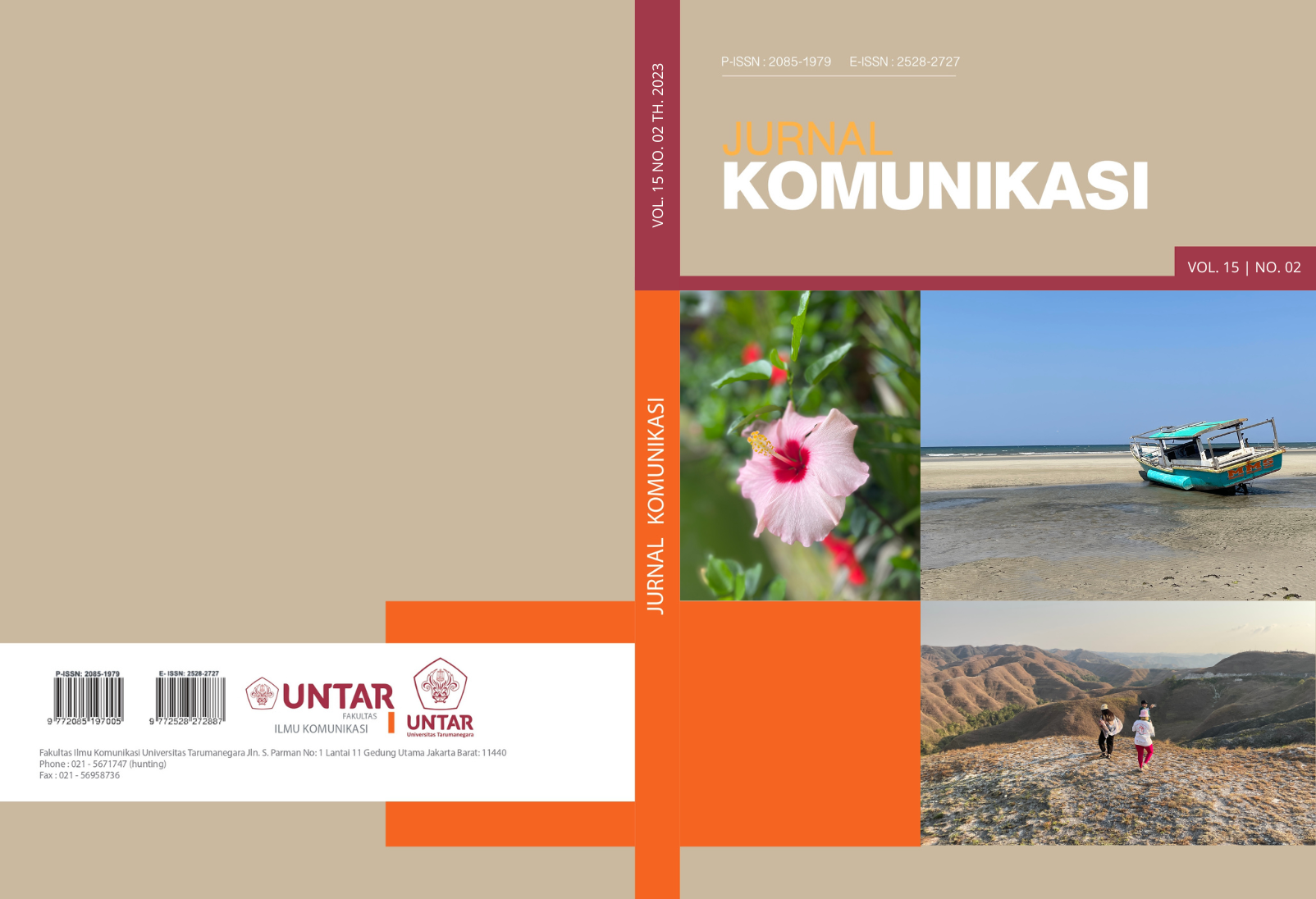Family Communication Model on Preserving Romance for Elderly Spouse
Main Article Content
Abstract
Every married couple would want to have a golden marriage that lasts happily ever after. There were 15 elderly couples who had entered a golden marriage being interviewed. This research was conducted at 2 regions (Bandung and Subang) in West Java. We used qualitative method with phenomenology approach. Data collecting was done through interview and observation. The results found that these elderly couples communicate in different ways to maintain their romances. They keep on their commitment in supporting the couple hobbies, being honest, doing nonverbal communication of romantic movement/gestures, saying thanks, and giving forgiveness sincerely. The model proposed on this research findings are being commitment, forgiveness, honesty, thanking, romance action and marriage as worship. These communication model that the elderly spouses applied in their daily life doesn’t seem smooth as it is. They always give the opportunity of each other to improve themselves better for the sake of long-lasting marriage. These elderly couples realized about their imperfectness and keep learning all the time to be mature couple. As they have matured mind, every barrier in the marriage will always solve wisely and happily by the couple. These family communication pattern have finally formed the long lasting marital harmony of romantic relationship between the elderly couple to create honor and trust.
Article Details
Section

This work is licensed under a Creative Commons Attribution-ShareAlike 4.0 International License.
This work is licensed under a Jurnal Komunikasi Creative Commons Attribution-ShareAlike 4.0 International License.How to Cite
References
Annur, Cindy. Mutia. (n.d.). Kasus Perceraian Meningkat 53%, Mayoritas karena Pertengkaran. Katadata.Co, 1. ttps://databoks.katadata.co.id/datapublish/2022/02/28/kasus-perceraian-meningkat-53-mayoritas-karena-pertengkaran.id)
August, Kristin J; Kelly, Caitlin. S. & Markey. Charlotte. N. (2016). Marriage, Romantic Relationships, and Health. In H. S. Friedman (Ed.), Encyclopedia of Mental Health: Second Edition (2nd ed., Vol. 1). Academic Press. https://doi.org/https://doi.org/10.1016/B978-0-12-397045-9.00074-4
Cahn, D Dudley & Abigail, Ruth. Anna. (2014). Managing conflict through communication (5th ed.). Pearson Education.
Carr, Deborah. & Utz. L. Rebecca. (2020). Families in Later Life: A Decade in Review. Journal of Marriage and Family, 82(1), 346–363. https://doi.org/https://doi.org/10.1111/jomf.12609
Creswell, John. W. & Cheryl. N. Poth. (2018). Qualitative Inquiry & Research Design: Choosing Among Five Approaches. Sage Publications.
Dhaliwal, Joya. (2021). What Are the Factors Contributing to Long-Lasting Marriages? https://www.proquest.com/openview/eeb7e6aa9219ce4ed9705b2fb18720ab/1.pdf?pq-origsite=gscholar&cbl=18750&diss=y
Fauzan, Ahmad; Putra, Ardian. Adi & Syaf. Auliya. (2022). Sense of Humor dalam Menjaga Kepuasan Pernikahan Pasangan Suami Istri. Psychopolytan: Jurnal Psikologi, 6(1), 38–44. https://doi.org/https://doi.org/10.36341/psi.v6i1.2560
Ferguson, David; Ferguson, Teresa; Thurman, Chris & Thurman, H. (1994). Intimate Encounters: A Practical Guide to Discovering the Secrets of a Really Great Marriage. Thomas Nelson Inc.
Gembeck, Melanie. J. Zimmer & Ducat. Wendy. (2016). Positive and Negative Romantic Relationship Quality: Age, Familiarity, Attachment and Well-Being as Correlates of Couple Agreement and Projection. Journal of Adolescene, 6(33), 79–90. https://doi.org/doi: 10.1016/j.adolescence.2010.07.008
Goldfarb, Maria R & Trudel, Giles. (2019). Marital Quality and Depression: a Review. Marriage & Family Review, 55(8), 737–763. https://doi.org/doi: 10.1080/01494929.2019.1610136
Levenson, Robert. W., Carstensen, Laura. L, & Gottman, John. M. (1993). Long-term marriage: age, gender, and satisfaction. Psychology and Aging, 8(2), 301–313. https://doi.org/doi: 10.1037//0882-7974.8.2.301
Kaslow, Florence. & Robinson. A. James. (2007). Long-term satisfying marriages: perceptions of contributing factors. The American Journal of Family Therapy, 24(2), 153–170. https://doi.org/https://doi.org/10.1080/01926189608251028
Kurtz, Laura E & Algoe, Sara. B. (2015). Putting Laughter in Context: Shared Laughter as Behavioral Indicator of Relationship Well-Being. Personal Relationship, 22(4), 573–590. https://doi.org/doi: 10.1111/pere.12095
Lenger, Katherine A; Gordon, Cameron L & Nguyen, Simone. P. (2019). A Word to the Wise: Age Matters When Considering Mindfulness in Romantic Relationships. Contempory Family Therapy, 41, 115–124. https://doi.org/https://doi.org/10.1007/s10591-018-9479-5
Lopez, Mercedes Gomez; Viejo Carmen; Ruiz, Rosaria. Ortega. (2019). Well-Being and Romantic Relationships: A Systematic Review in Adolescence and Emerging Adulthood. Int J Environ Res Public Health, 13(16), 2415. https://doi.org/https://doi.org/10.3390/ijerph16132415
Muise, Amy; Harasymuck, Cheryl; Day, C Lisa; Giles, Chantal Bacev; Gere, Judith & Impett, E. A. (2019). Broadening your horizons: Self-expanding activities promote desire and satisfaction in established romantic relationships. Journal of Personality & Social Psychology, 116(2), 237–258. https://doi.org/doi: 10.1037/pspi0000148
Olson, David; DeFrain, John & Skogrand, Linda. (2010). Marriages and families: Intimacy, diversity, and strengths. McGraw-Hill Companies.
Putra, Irwansyah. BKKBN: Jumlah Lansia Meningkat Hingga Mencapai 19,9 Persen Pada 2045. Media Indonesia.Com. Retrieved February 23, 2023, from https://mediaindonesia.com/humaniora/529728/bkkbn-jumlah-lansia-meningkat-hingga-mencapai-199-persen-pada-2045
Raffagino, Rosalba. Puddu. Luisa. (2018). Love Styles in Couple Relationships: A Literature Review. Open Journal of Social Sciences, 6(12), 307–330. https://doi.org/doi: 10.4236/jss.2018.612027
Saroglou, Vassilis; Lacour, Christelle; Demeure, Maria. Eve. (2010). Bad Humor, Bad Marriage: Humor Styles in Divorced and Married Couples. Europe’s Journal of Psychology, 6(3), 94–121. https://doi.org/DOI: 10.5964/ejop.v6i3.210
Stenberg, Robert. J. (1986). A Triangular Theory of Love. Psychological Review, 93(2), 119–135. https://doi.org/https://doi.org/10.1037/0033-295X.93.2.119
Supratman, Lucy. Pujasari. (2019). A Qualitative Study Of Teenagers Viewpoint In Dealing With Parents’ Divorce In Indonesia. Journal of Divorce and Remarriage, 61(4), 287–299. https://doi.org/DOI: 10.1080/10502556.2019.1699374
Wallerstein, Judith S & Blakeslee, Sandra. (1996). The Good Marriage: How and Why Love Lasts. Warner.
Wrench, Jason S; Carter, Narsissra M Punyanunt & Thweatt, K. S. (2020). Interpersonal Communication: A Mindful Approach to Relationships (1st ed.). Open SUNY Textbooks.

